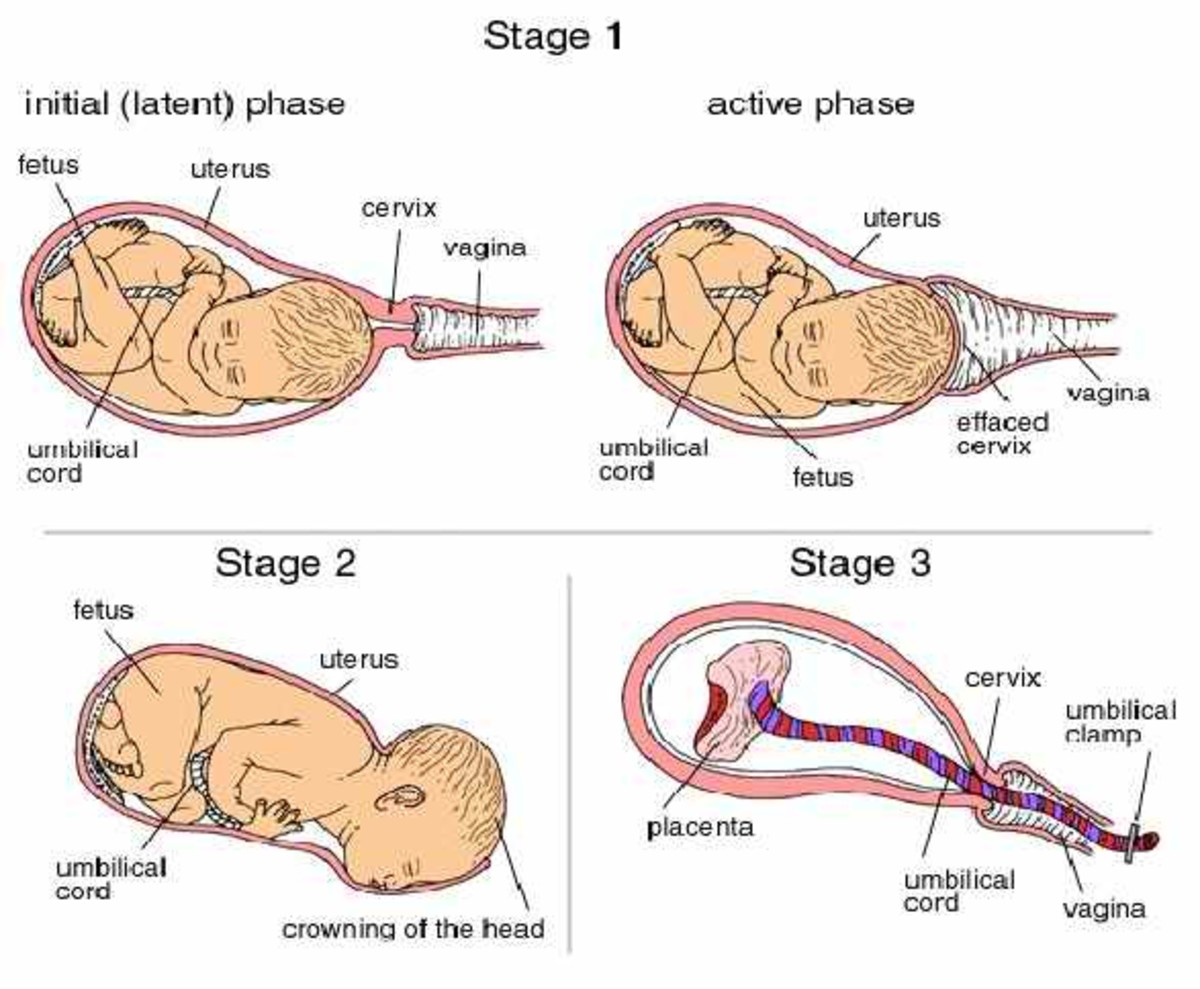- HubPages»
- Health»
- Women's Health»
- Pregnancy
What happens when you go in the hospital to have a baby
The first one since my own

Getting to be an Expert at this!
Having just come home from the Hospital after witnessing the birth of my Grandson. Also after having delivered 5 of my own children and being present at the birth of 3 other Grandchildren I can say with a fair amount of certainty, that I am fast becoming an expert on child birth. Not many people are allowed these kinds of opportunities, I feel very fortunate.
What I am about to divulge is for what would be termed a ’normal’ pregnancy and delivery and also Cesarean or C-section delivery. If you have special needs you will know this before you even go.
When it is time to go; unless you live miles and miles away, and have been otherwise directed by your Doctor, if your pains/contraction are at 3 minute intervals then it would be time to leave for the hospital. Getting there any earlier is just going to frustrate you and your partner. So remain calm, do some walking and breathing (in through the nose, out through the mouth) and wait until those pains are 3 minutes apart.
How to time them
When you time your contractions and they are 3 minutes apart, lasting anywhere from 45 seconds to 1 ½ minutes and they are consistent then you know you are in labor. Consistent means; they become relatively the same, not coming 3 minutes then the next one 10 minutes then 8 minutes and so on. They need to be regular for them to do any good.
Time the contraction (using stopwatch, cell phone or clock with a minute hand) when it begins, and for how long it lasts. It will come in a 'wave', starting not hard, slight pressure, small amount of pain, getting stronger or more painful, then begin to subside. There will be a tightening across the top of your uterus/abdomen during this process, which at times can be felt from the outside.
If they aren’t ‘regular’ and it is still too early for your delivery, try drinking water, at times being dehydrated will cause Braxton Hicks contractions which will do you no good, other than be in pain.
What happens during labor is the cervix thins and opens to allow for passage of the baby. If your contractions aren’t regular this process will not happen. Try relaxing, putting your feet up to see if they either get regular or go away.
Above all RELAX!
When you get to the hospital you will be greeted by the receptionist who will ask your name and give you a bracelet so everyone who looks at it will know who you are. You may be offered a wheelchair to be taken to the birthing area. If you are in a great deal of pain you may choose this option.
Once in the birthing area you will be asked to change into a hospital gown and may be asked to give a urine sample, this is to determine if you have a urinary tract infection causing to you experience labor pains. This may happen particularly if you are a few weeks from your due date.
When you are in your gown your Nurse may put a set of monitor’s on your belly, one is for the baby’s heart rate and the other is for monitoring the contractions. If you are experiencing back labor the contractions may not appear of the monitor. You may be given a ‘button’ to push to mark the contractions. This is to help them determine if you are in true labor.
The Nurse may then do an examination of you. This is not pleasant but IS necessary. They will put on a glove and using some form of lubrication check your cervix. This is done with their hand, and can be painful, at the very least uncomfortable. What they will be checking for is to see if your cervix has thinned and if you are beginning to dilate. In order for the baby to pass through, the cervix should be dilated to 10 centimeters.
If you are dilated less than 3 centimeters and your ’water’ (amniotic fluid) hasn’t broken, they may send you home to walk. Walking is supposed to keep your mind off your pain, and help you to relax. Relaxation is the key to having a swift delivery. If you can relax as much as possible it will allow the body to do what it needs to 'open' up so the baby can pass through.
IV's are not all bad!
If you are truly in Labor the Nurse may then give you an IV. This is a needle that is inserted usually in the hand (possibly elsewhere) to administer fluids. It is also used for inserting other medications. The body loses a lot of fluid during labor and delivery, this may be necessary for your health as well as your baby’s health.
If you are in a great deal of pain (they will ask you on a scale of 1 to 10 (10 being the worst) your level of pain) they may give you something to help relax you a bit. One of the types of medication is Stadol, it will help relax you so you can dilate. It doesn’t relieve all the pain but it does make it a bit more tolerable, it ’takes the edge off’ of the pain.
Relaxing may be difficult but it is the key to a smooth delivery. Try focusing on something during a contraction. If you have a birthing partner having them massage your feet or calves helps. Sometimes it may seem irritating but during the contraction if you focus on something else, it will help you through.
Dilating to 8
Your Nurse will not stay with you the entire time, they have things to do, people to call such as your Doctor. They also have other patients to tend to, as important as you feel you and your baby are, there are others in need too. Your Doctor may not be on duty when you go in, try not to get upset at this. It happens. This is why having a birthing partner to help you is nice.
If it appears that you will be having a normal delivery you may be allowed ice chips to chew on. As the pressure increases during labor your uterus pushes up against your stomach and can cause vomiting. This is why you are not allowed anything to eat or drink during labor.
If you need to have an emergency C-section fluids or food will not be tolerated well by the body. NO SNEAKING DRINKS!! It is very important that you follow this.
When you dilate to 8 (this is determined through checking as explained previously) they will begin preparing for the birth, possibly moving you to a delivery room (depending on your hospital.
If you choose an Epidural
You may be draped with sterilized cloths at this time and your feet may be put in stirrups, which keep your legs out of the way. At this time your birthing partner may have to change into ‘scrubs’ and should remain by your head, out of the way of those working around you.
If you have opted for an Epidural this will be done by a Anesthesiologist. You will be asked to sit on the edge of the bed in a curled position while a needle is inserted in your lower back. Medicine will then be dispensed this way to numb your lower half. Remember, you are in labor so this will not be easy, you will be instructed to NOT move.
You will have to remain in the hospital a little longer if you choose this option. Most deliveries that do not use this are out within 24 hours (provided everything is OK) it will take an extra day with this. This is to make sure that all is well with you and there are no lasting effects of the medicine.
Don't stop now!
Eventually you will feel a sensation that causes you to want to push. The best way to describe this is the sensation of having a bowel movement, only bigger. Your Nurse may tell you it isn’t time yet and may want you to breathe through it, this is done ‘In through the nose - Out through the mouth‘. The reason is possibly the cervix hasn’t thinned enough and needs a bit more time, a few more contractions. If you try to push too soon it could cause swelling and a little rougher delivery.
When it’s time to push. They will ask you to take a big breath and begin pushing, counting to 10. Then relax. Then again the same. At some point they may ask you to hold it, to either hold the push or not push. They might be adjusting the baby’s head at this point.
If you have opted for the Epidural, the sensation will be different. You may get more tired and want to push less. This is where your partner can come in handy. He or she will need to make you a bit angry, to 'push' that baby out! When the baby is in the birth canal and his/her head is almost out this is a dangerous time for the baby. It can't just sit in there waiting until you feel like pushing, now is not the time to stop! If your partner can get behind you a bit and help you, then this will help a lot.
There will be a burning sensation as the baby begins to come out, this will go away. Once the baby’s head is out the Doctor may clear the baby’s nose and mouth, then tell you to give one more good push. This will clear the shoulders. Voila` your baby will be out.
They will do the necessary things like cutting the cord and such. Shortly after this you will ‘deliver’ the after birth. It will come upon you like another pushing sensation but is much easier. Generally all that is needed is one push.
Enjoy your baby!
Once your baby is born, one of the Nurses will clean him/her up they may weigh and measure him. He will be kept under a warmer and a cap put on his head to keep in his warmth. The Doctor will be working on you at this time. To make things easier for you, if you should keep an eye on what’s going on with your baby you won’t concentrate so hard on what the Doctor is doing. You may need a stitch or two.
When the Doctor has finished cleaning you up, you will be reunited with your baby and have a chance to cuddle. If you will be breast feeding your Nurse may give you a hand and show you how. From time to time your Nurse will check your vaginal area to make sure there isn’t too much bleeding or clotting. They know what to look for, you will have to trust them on this.
C-Section
If you should need a C-section, you Doctor will notify you within minutes of his examination. It could be for various reasons. Breach (meaning anything but the head coming out first), face first (the baby’s head is turned wrong and refuses to turn right) or any reason that your Doctor determines necessary.
Do not argue with him on this, it is for your benefit as well as the baby. If this should happen you will have to sign some forms. Your Doctor will tell you why it needs to happen. They don’t just cut people open for no good reason.
You will be given a catheter, it will be inserted so you don’t wet the bed. This is because during a C-Section delivery you will be numb from the waist down and won’t feel the urge to urinate. You don’t want to pee on the baby do you? They will also measure the amount you go after the baby is born. As a Nurse once told me after the birth of my last daughter “Peeing indicates life, if you pee you‘re alive”.
You may also be shaved during this time, it is called 'prep' for operating.
No peeking under the drape!
You will be taken to an operating room and prepared for your surgery. Your birthing partner may be allowed in depending on Hospital policy. If this is the case your partner will be expected to sit at your head. You will be draped with a cloth so you cannot see what is happening. The reason for this is some people faint at the site of blood and they don’t need another patient.
Once the baby has been taken out of your body he/she will be taken care of by the Nurses in the room. He will have his cord clipped and an ’APGAR’ score taken. This is done at birth, the 1st minute and 5 minutes later. He may be given oxygen, his nose and mouth will be cleaned out. His body will be wiped down and he will be wrapped in warm blankets. You may get to see him for a minute or two before he is taken to the nursery. At this time your birthing partner may be allowed to go with the child.
Take LOTS of pictures!
If cameras are allowed, lots of pictures can be taken of the blessed event. You will be taken care of by your Physician at this time. It may take a little while, have no fear your baby will be well taken care of.
Some hospitals are now opting for alarms to be put on the baby. This is for their protection as well as yours. The baby will not be allowed beyond certain points on the floor, if this should happen alarms will go off and there will be a search for your baby.
Once your finished in the operating room you may be wheeled by the nursery to see your baby. Then if all is well you and your baby will be taken to your room. The Nurse may check your incision from time to time to make sure there is no excess bleeding.
A Little R & R is all you need
Now is the time to relax and enjoy your baby. If at any time you have questions feel free to ask them. They are there to help you and want you to ask.
Right now you have help with the Nurses and Doctors, let them help you as much as possible. Rest as much as you can because once you are home, the FUN begins!!








